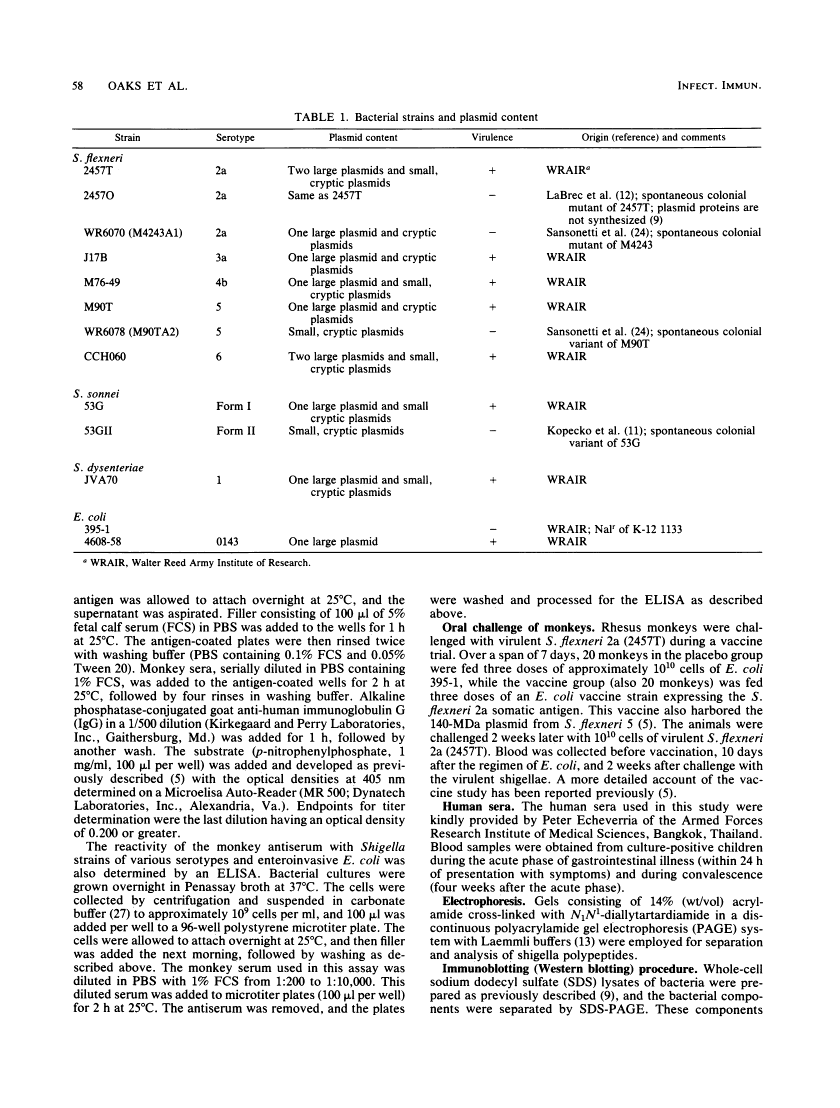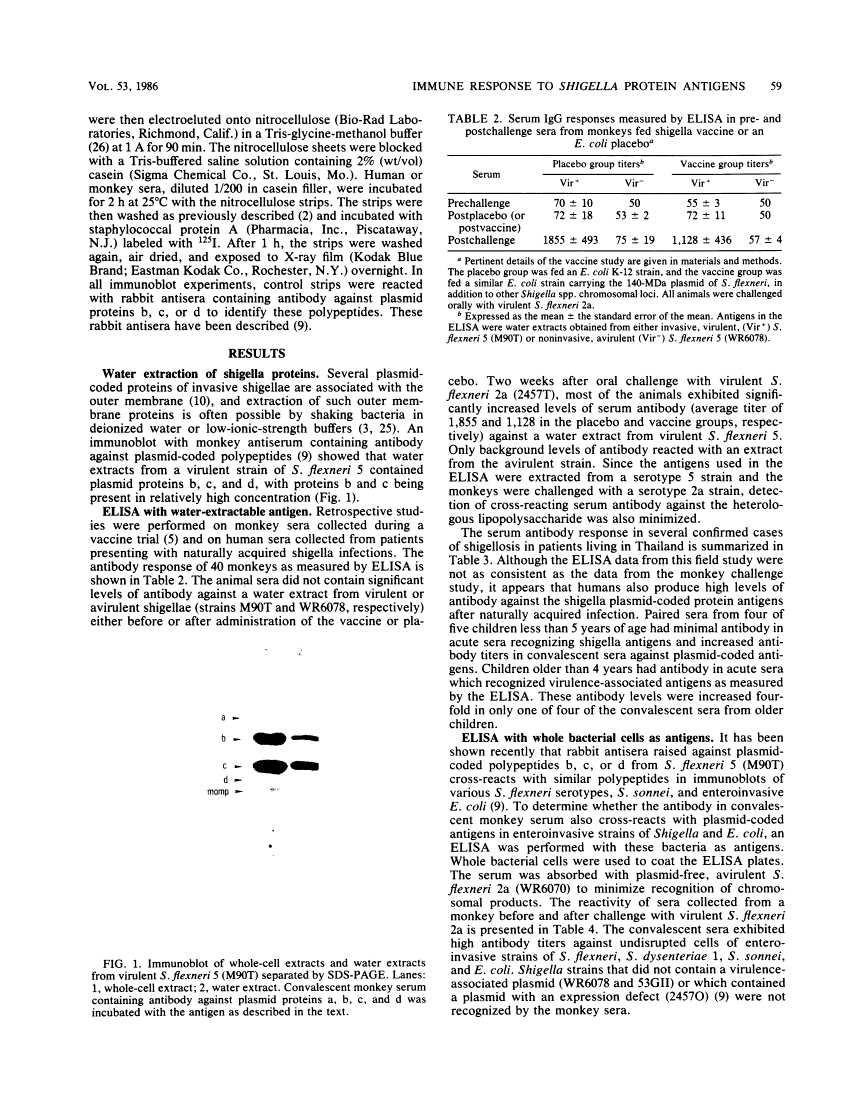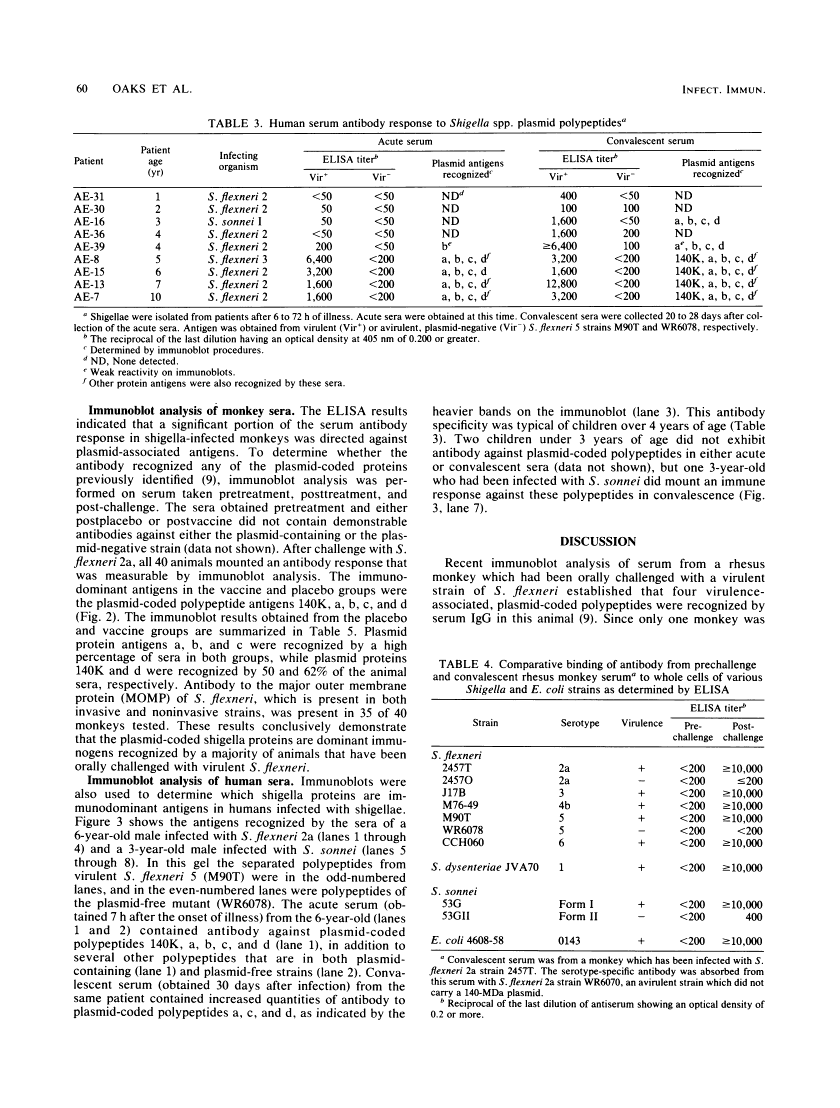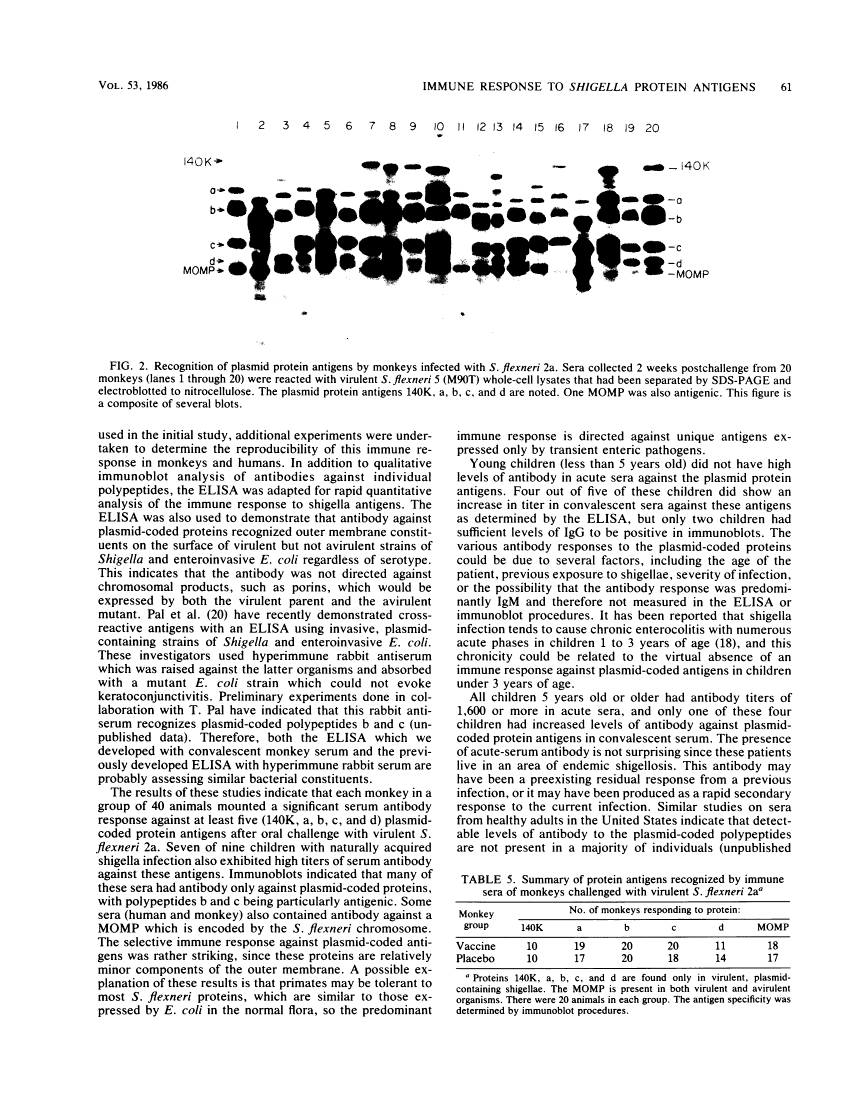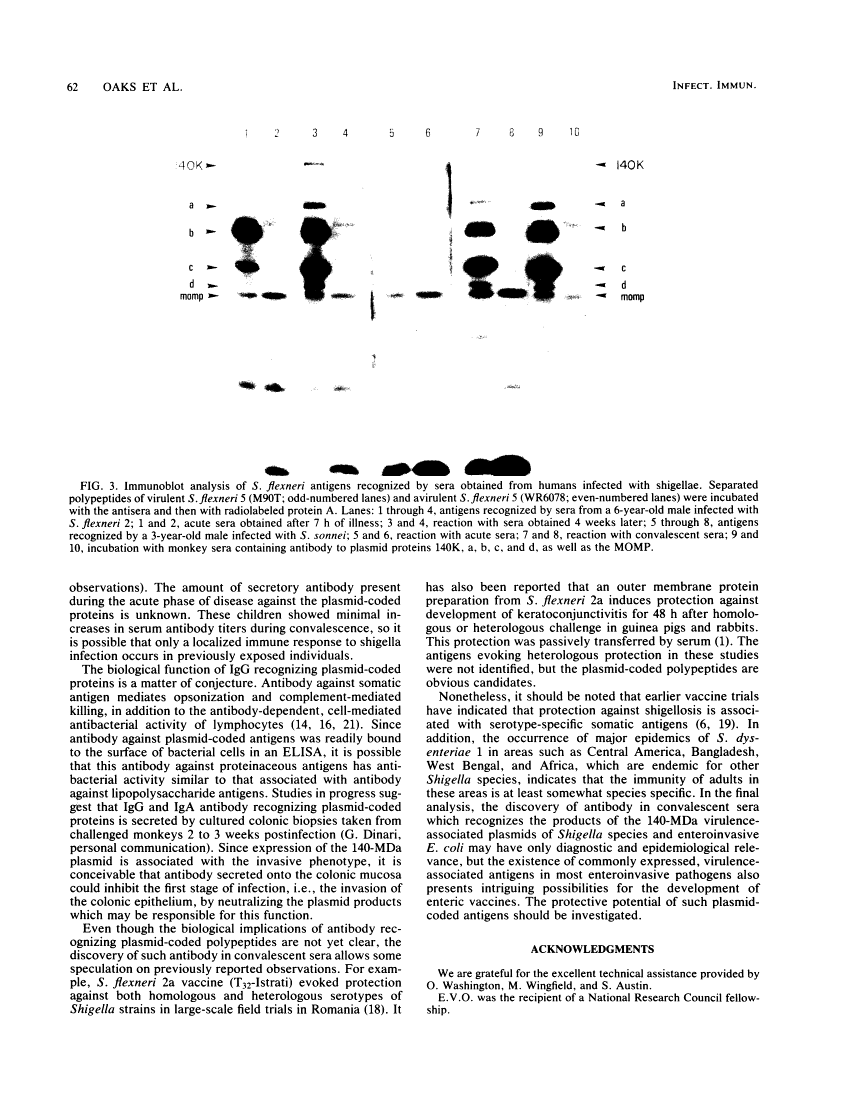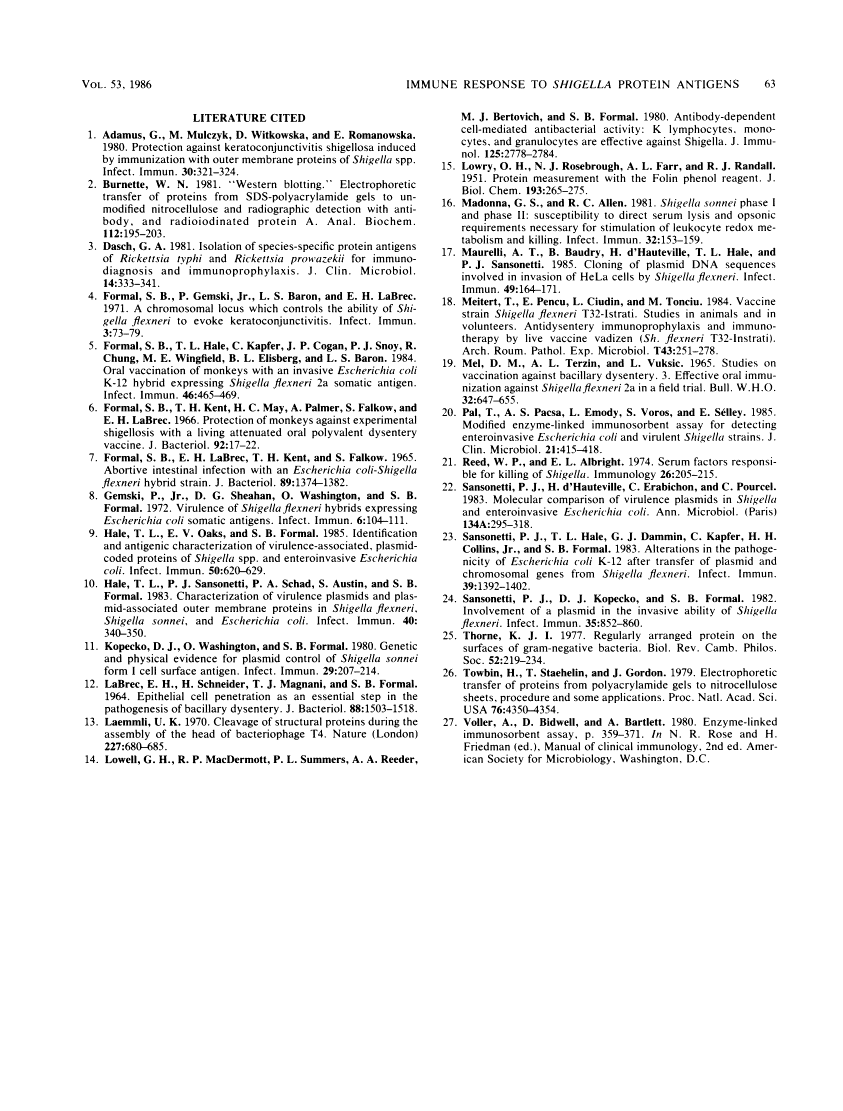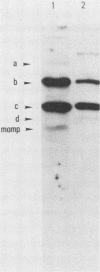Abstract
Free full text

Serum immune response to Shigella protein antigens in rhesus monkeys and humans infected with Shigella spp.
Abstract
The serum antibody response to proteins encoded by the virulence-associated plasmid of Shigella flexneri was determined in monkeys challenged with virulent S. flexneri serotype 2a. With water-extractable antigen in an enzyme-linked immunosorbent assay, a significant increase in antibody titer against proteins from a plasmid-carrying, virulent strain of S. flexneri serotype 5 could be demonstrated in convalescent sera. There were minimal antibody titers against proteins from an avirulent (plasmid-free) organism. Previously identified plasmid-coded polypeptides a, b, c, and d were predominant antigens recognized by a majority of the convalescent sera in immunoblots. An additional 140-megadalton plasmid-coded polypeptide was also recognized by half of the sera. Convalescent serum from an infected monkey recognized antigens on the bacterial surface in several different plasmid-containing Shigella species and in an enteroinvasive Escherichia coli strain. A survey of sera obtained from children 5 to 10 years of age who had been infected with S. flexneri or S. sonnei revealed high enzyme-linked immunosorbent assay titers in both acute and convalescent sera against a water extract from a virulent Shigella strain. In contrast, children under 3 years of age had no antibody titer in either acute or convalescent sera against the virulence-associated shigella proteins, while 3- to 4-year-old children mounted an immune response against these proteins only in convalescence.
Full text
Full text is available as a scanned copy of the original print version. Get a printable copy (PDF file) of the complete article (1.7M), or click on a page image below to browse page by page. Links to PubMed are also available for Selected References.
Images in this article
Selected References
These references are in PubMed. This may not be the complete list of references from this article.
- Adamus G, Mulczyk M, Witkowska D, Romanowska E. Protection against keratoconjunctivitis shigellosa induced by immunization with outer membrane proteins of Shigella spp. Infect Immun. 1980 Nov;30(2):321–324. [Europe PMC free article] [Abstract] [Google Scholar]
- Burnette WN. "Western blotting": electrophoretic transfer of proteins from sodium dodecyl sulfate--polyacrylamide gels to unmodified nitrocellulose and radiographic detection with antibody and radioiodinated protein A. Anal Biochem. 1981 Apr;112(2):195–203. [Abstract] [Google Scholar]
- Dasch GA. Isolation of species-specific protein antigens of Rickettsia typhi and Rickettsia prowazekii for immunodiagnosis and immunoprophylaxis. J Clin Microbiol. 1981 Sep;14(3):333–341. [Europe PMC free article] [Abstract] [Google Scholar]
- Formal SB, Gemski P, Baron LS, Labrec EH. A Chromosomal Locus Which Controls the Ability of Shigella flexneri to Evoke Keratoconjunctivitis. Infect Immun. 1971 Jan;3(1):73–79. [Europe PMC free article] [Abstract] [Google Scholar]
- Formal SB, Hale TL, Kapfer C, Cogan JP, Snoy PJ, Chung R, Wingfield ME, Elisberg BL, Baron LS. Oral vaccination of monkeys with an invasive Escherichia coli K-12 hybrid expressing Shigella flexneri 2a somatic antigen. Infect Immun. 1984 Nov;46(2):465–469. [Europe PMC free article] [Abstract] [Google Scholar]
- Formal SB, Kent TH, May HC, Palmer A, Falkow S, LaBrec EH. Protection of monkeys against experimental shigellosis with a living attenuated oral polyvalent dysentery vaccine. J Bacteriol. 1966 Jul;92(1):17–22. [Europe PMC free article] [Abstract] [Google Scholar]
- FORMAL SB, LABREC EH, KENT TH, FALKOW S. ABORTIVE INTESTINAL INFECTION WITH AN ESCHERICHIA COLI-SHIGELLA FLEXNERI HYBRID STRAIN. J Bacteriol. 1965 May;89:1374–1382. [Europe PMC free article] [Abstract] [Google Scholar]
- Gemski P, Jr, Sheahan DG, Washington O, Formal SB. Virulence of Shigella flexneri hybrids expressing Escherichia coli somatic antigens. Infect Immun. 1972 Aug;6(2):104–111. [Europe PMC free article] [Abstract] [Google Scholar]
- Hale TL, Oaks EV, Formal SB. Identification and antigenic characterization of virulence-associated, plasmid-coded proteins of Shigella spp. and enteroinvasive Escherichia coli. Infect Immun. 1985 Dec;50(3):620–629. [Europe PMC free article] [Abstract] [Google Scholar]
- Hale TL, Sansonetti PJ, Schad PA, Austin S, Formal SB. Characterization of virulence plasmids and plasmid-associated outer membrane proteins in Shigella flexneri, Shigella sonnei, and Escherichia coli. Infect Immun. 1983 Apr;40(1):340–350. [Europe PMC free article] [Abstract] [Google Scholar]
- Kopecko DJ, Washington O, Formal SB. Genetic and physical evidence for plasmid control of Shigella sonnei form I cell surface antigen. Infect Immun. 1980 Jul;29(1):207–214. [Europe PMC free article] [Abstract] [Google Scholar]
- Labrec EH, Schneider H, Magnani TJ, Formal SB. EPITHELIAL CELL PENETRATION AS AN ESSENTIAL STEP IN THE PATHOGENESIS OF BACILLARY DYSENTERY. J Bacteriol. 1964 Nov;88(5):1503–1518. [Europe PMC free article] [Abstract] [Google Scholar]
- Laemmli UK. Cleavage of structural proteins during the assembly of the head of bacteriophage T4. Nature. 1970 Aug 15;227(5259):680–685. [Abstract] [Google Scholar]
- Lowell GH, MacDermott RP, Summers PL, Reeder AA, Bertovich MJ, Formal SB. Antibody-dependent cell-mediated antibacterial activity: K lymphocytes, monocytes, and granulocytes are effective against shigella. J Immunol. 1980 Dec;125(6):2778–2784. [Abstract] [Google Scholar]
- LOWRY OH, ROSEBROUGH NJ, FARR AL, RANDALL RJ. Protein measurement with the Folin phenol reagent. J Biol Chem. 1951 Nov;193(1):265–275. [Abstract] [Google Scholar]
- Madonna GS, Allen RC. Shigella sonnei phase I and phase II: susceptibility to direct serum lysis and opsonic requirements necessary for stimulation of leukocyte redox metabolism and killing. Infect Immun. 1981 Apr;32(1):153–159. [Europe PMC free article] [Abstract] [Google Scholar]
- Maurelli AT, Baudry B, d'Hauteville H, Hale TL, Sansonetti PJ. Cloning of plasmid DNA sequences involved in invasion of HeLa cells by Shigella flexneri. Infect Immun. 1985 Jul;49(1):164–171. [Europe PMC free article] [Abstract] [Google Scholar]
- Meitert T, Pencu E, Ciudin L, Tonciu M. Vaccine strain Sh. flexneri T32-Istrati. Studies in animals and in volunteers. Antidysentery immunoprophylaxis and immunotherapy by live vaccine Vadizen (Sh. flexneri T32-Istrati). Arch Roum Pathol Exp Microbiol. 1984 Jul-Dec;43(3-4):251–278. [Abstract] [Google Scholar]
- Mel DM, Terzin AL, Vuksić L. Studies on vaccination against bacillary dysentery. 3. Effective oral immunization against Shigella flexneri 2a in a field trial. Bull World Health Organ. 1965;32(5):647–655. [Europe PMC free article] [Abstract] [Google Scholar]
- Pál T, Pácsa AS, Emödy L, Vörös S, Sélley E. Modified enzyme-linked immunosorbent assay for detecting enteroinvasive Escherichia coli and virulent Shigella strains. J Clin Microbiol. 1985 Mar;21(3):415–418. [Europe PMC free article] [Abstract] [Google Scholar]
- Reed WP, Albright EL. Serum factors responsible for killing of Shigella. Immunology. 1974 Jan;26(1):205–215. [Abstract] [Google Scholar]
- Sansonetti PJ, d'Hauteville H, Ecobichon C, Pourcel C. Molecular comparison of virulence plasmids in Shigella and enteroinvasive Escherichia coli. Ann Microbiol (Paris) 1983 May-Jun;134A(3):295–318. [Abstract] [Google Scholar]
- Sansonetti PJ, Hale TL, Dammin GJ, Kapfer C, Collins HH, Jr, Formal SB. Alterations in the pathogenicity of Escherichia coli K-12 after transfer of plasmid and chromosomal genes from Shigella flexneri. Infect Immun. 1983 Mar;39(3):1392–1402. [Europe PMC free article] [Abstract] [Google Scholar]
- Sansonetti PJ, Kopecko DJ, Formal SB. Involvement of a plasmid in the invasive ability of Shigella flexneri. Infect Immun. 1982 Mar;35(3):852–860. [Europe PMC free article] [Abstract] [Google Scholar]
- Thorne KJ. Regularly arranged protein on the surfaces of Gram-negative bacteria. Biol Rev Camb Philos Soc. 1977 May;52(2):219–234. [Abstract] [Google Scholar]
- Towbin H, Staehelin T, Gordon J. Electrophoretic transfer of proteins from polyacrylamide gels to nitrocellulose sheets: procedure and some applications. Proc Natl Acad Sci U S A. 1979 Sep;76(9):4350–4354. [Europe PMC free article] [Abstract] [Google Scholar]
Associated Data
Articles from Infection and Immunity are provided here courtesy of American Society for Microbiology (ASM)
Full text links
Read article at publisher's site: https://doi.org/10.1128/iai.53.1.57-63.1986
Read article for free, from open access legal sources, via Unpaywall:
https://iai.asm.org/content/iai/53/1/57.full.pdf
Free after 4 months at iai.asm.org
http://iai.asm.org/cgi/reprint/53/1/57
Free to read at iai.asm.org
http://iai.asm.org/cgi/content/abstract/53/1/57
Citations & impact
Impact metrics
Citations of article over time
Alternative metrics
Smart citations by scite.ai
Explore citation contexts and check if this article has been
supported or disputed.
https://scite.ai/reports/10.1128/iai.53.1.57-63.1986
Article citations
Shigella-Controlled Human Infection Models: Current and Future Perspectives.
Curr Top Microbiol Immunol, 445:257-313, 01 Jan 2024
Cited by: 2 articles | PMID: 35616717 | PMCID: PMC7616482
Review Free full text in Europe PMC
Bioactivity and efficacy of a hyperimmune bovine colostrum product- Travelan, against shigellosis in a non-Human primate model (Macaca mulatta).
PLoS One, 18(12):e0294021, 13 Dec 2023
Cited by: 1 article | PMID: 38091314 | PMCID: PMC10718440
Development of the Shigella flexneri 2a, 3a, 6, and S. sonnei artificial Invaplex (InvaplexAR) vaccines.
mSphere, 8(4):e0007323, 30 Jun 2023
Cited by: 2 articles | PMID: 37389412 | PMCID: PMC10449495
Functional assays to evaluate antibody-mediated responses against Shigella: a review.
Front Cell Infect Microbiol, 13:1171213, 16 May 2023
Cited by: 9 articles | PMID: 37260708 | PMCID: PMC10227456
Review Free full text in Europe PMC
Dynamics of the Gut Microbiome in Shigella-Infected Children during the First Two Years of Life.
mSystems, 7(5):e0044222, 19 Sep 2022
Cited by: 6 articles | PMID: 36121169 | PMCID: PMC9600951
Go to all (142) article citations
Similar Articles
To arrive at the top five similar articles we use a word-weighted algorithm to compare words from the Title and Abstract of each citation.
Identification and antigenic characterization of virulence-associated, plasmid-coded proteins of Shigella spp. and enteroinvasive Escherichia coli.
Infect Immun, 50(3):620-629, 01 Dec 1985
Cited by: 97 articles | PMID: 3905608 | PMCID: PMC261123
Antibody response of monkeys to invasion plasmid antigen D after infection with Shigella spp.
Clin Diagn Lab Immunol, 3(2):242-245, 01 Mar 1996
Cited by: 14 articles | PMID: 8991646 | PMCID: PMC170291
Recognition of three epitopic regions on invasion plasmid antigen C by immune sera of rhesus monkeys infected with Shigella flexneri 2a.
Infect Immun, 63(10):3927-3935, 01 Oct 1995
Cited by: 18 articles | PMID: 7558301 | PMCID: PMC173552
Shigellosis in Vietnam: seroepidemiologic studies with use of lipopolysaccharide antigens in enzyme immunoassays.
Rev Infect Dis, 13 Suppl 4:S231-7, 01 Mar 1991
Cited by: 9 articles | PMID: 2047643
Review

